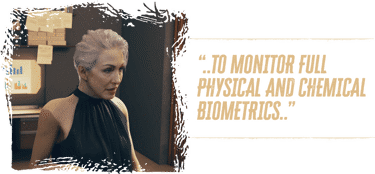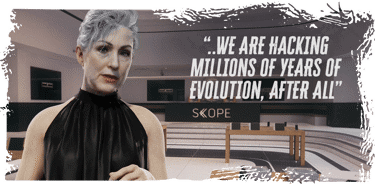Hello Singularity –
Lola Konradt, BrinK,
and a brave, new world.
Gail Hoffer, OSK Magazine.

I’ve only been waiting for two minutes when Lola Konradt glides into our working breakfast together, her signature barefoot elegance and warm smile immediately putting me at ease. She’s one of the most powerful technologists on Earth, yet I feel like I’m meeting my mom for toast and coffee.

PHOTO: Lola Konradt, First human implanted with Brink Technology
“Hi Gail, it’s lovely to meet you.”
As she approaches the collection of easy sofas around the low, polished-granite coffee table, the idyllic sunroom reacts to her like she’s a Disney princess in an enchanted castle. Individual polygons of glass in the large windows polarize, creating a sunshade that walks across the pane, tracking her movement across the room. As she lowers herself amidst the cushions and throws, their designs shift to tweeds that compliment her color palette. An OSK cafetiere hisses gently to life and the tabletop produces news feeds and articles, showing the granite finish as a sophisticated illusion.
This is, of course, all part of the show. I’m here to interview the first human to be implanted with BrinK technology, OSK’s great leap toward The Singularity. Linking her directly to OSK and the ubiquitous OSK tech in this room, it’s like meeting a time traveler from the future.
“I’m getting used to that look,”
she laughs,
“this is a threshold as important as the discovery of language. But it is easier than you might think; I’m not telling this room to do anything. OSK is the enabler here, the perfect listener, and it will react to my desires before I’m even aware that I had an opinion.”

PHOTO: Lola Konradt
Konradt is open about the challenges and all the small steps along the way to full connectivity, “First iterations of BrinK will replace the functions of your smartwatch, say, like push notifications, basic biometric monitoring, and such. But you can see how the technology will ultimately be able to monitor full physical and chemical biometrics, understand sub vocalized thought, and even detect long-term, and immediate intentions of the user. And then there’s interconnectivity with other BrinKers…”

PHOTO: Lola Konradt
I am rarely stunned, but I am stunned, “Do you mean telepathy?”, I blurt out excitedly, all pretense of professionalism gone.
“Sure. Telepathy, empathy, shared perspectives, and experiences. Never feel alone. We are at first stages with regard social and psychological prototyping at a dedicated site and the results are promising at this point, but we are advancing cautiously. We are hacking millions of years of evolution, after all.”
As Lola finishes her coffee a single Amaretti rises from a tiny dumb waiter in the tabletop, “Mmm, perfect!” As she nibbles the biscuit, I decide it’s time to address the elephant in the room, “BrinK is an implant, correct?”
"Our proprietary technology is organic, self-organizing.."
“Yes, although we regard that term as anachronistic. The human body is a complex and varied thing, so we needed to avoid invasive surgery, or force a one-size-fits all piece of monolithic hardware upon our delicate physiology. Our proprietary technology is organic, self-organizing, and introduced via a non-invasive solution that we are calling ‘infusion’. The process takes about an hour and is painless, and it’s the body itself that guides how the technology deploys and handshakes with anatomy.”
This is a lot to take in and I’m glad to see an aid enter the room indicating that Lola’s valuable time with me is at an end. As she rises to leave, I ask the question on all our lips, “How soon will BrinK be available to consumers?”
Lola Konradt pauses for a moment, her back turned to me, as if considering this answer carefully. It’s hard to read her expression, perhaps a hint of frustration?
“Not soon enough.”
So typical of this enigmatic luminary, she fills me with hope for the future.


